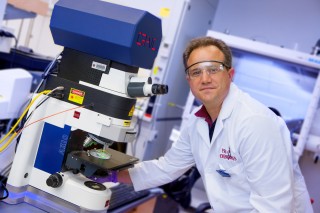Discovery Changes How Scientists Examine Rarest Elements of Periodic Table

Bill Lax/Florida State University Thomas Albrecht-Schmitt is the Gregory R. Choppin Professor of Chemistry at Florida State.
According to new research by a Florida State University professor, californium is what’s known to be a transitional element, meaning it links one part of the Periodic Table of Elements to the next.
Why’s that important?
Despite the fact that you may have memorized the periodic table in high school chemistry, there is actually very little known about the elements at the very end of the table. But, these elements are some of the heaviest and least understood chemical elements on the planet and information about them may prove crucial in the future as we look at how to store or recycle used nuclear fuel, among other things.
So learning what californium can or cannot do is a pretty big deal.
In a new Nature Communications paper, Professor Thomas Albrecht-Schmitt found that californium is an element that helps link one part of the periodic table to the next.
It has properties included in the three elements before it on the table — americium, curium and berkelium — and also the three elements after it — einsteinium, fermium and mendelevium. It gives the element unique capabilities that make it ripe for further research.
“This really changes how we think about the periodic table,” Albrecht-Schmitt said. “It’s important because we understand very little about these heavy elements. Governments and universities invest a lot of resources — financial, time and intellectual — into learning more about these elements.”
Getting a piece of californium is no easy task though.
After years of negotiating with the U.S. Department of Energy, Albrecht-Schmitt obtained 5 milligrams of californium through an endowment to the university in honor of retired Professor Gregory Choppin.
Those 5 milligrams have been the subject of multiple experiments, including several last year that led to Albrecht-Schmitt’s team discovering that californium had the ability to bond with and separate other materials.
This new round of experiments took almost two years to complete.
All the experiments were conducted at Florida State, but Albrecht-Schmitt worked with theorists and scientists from several other institutions including Oak Ridge National Laboratory, which supplied the californium, and the Florida State-based National High-Field Magnet Laboratory.
Other institutions contributing to the research are the University of Alabama and Argonne National Laboratory.
Contact Information
Kathleen Haughney
Research Media & Content Specialist
khaughney@fsu.edu
Phone: 850-644-1489
Media Contact
More Information:
http://www.fsu.edu/All latest news from the category: Life Sciences and Chemistry
Articles and reports from the Life Sciences and chemistry area deal with applied and basic research into modern biology, chemistry and human medicine.
Valuable information can be found on a range of life sciences fields including bacteriology, biochemistry, bionics, bioinformatics, biophysics, biotechnology, genetics, geobotany, human biology, marine biology, microbiology, molecular biology, cellular biology, zoology, bioinorganic chemistry, microchemistry and environmental chemistry.
Newest articles

A ‘language’ for ML models to predict nanopore properties
A large number of 2D materials like graphene can have nanopores – small holes formed by missing atoms through which foreign substances can pass. The properties of these nanopores dictate many…

Clinically validated, wearable ultrasound patch
… for continuous blood pressure monitoring. A team of researchers at the University of California San Diego has developed a new and improved wearable ultrasound patch for continuous and noninvasive…

A new puzzle piece for string theory research
Dr. Ksenia Fedosova from the Cluster of Excellence Mathematics Münster, along with an international research team, has proven a conjecture in string theory that physicists had proposed regarding certain equations….



